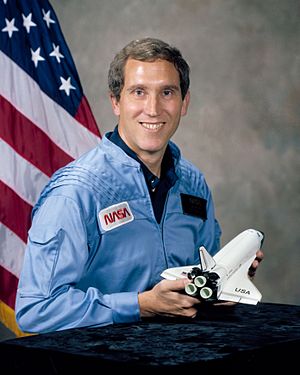Michael John Smith facts for kids
Quick facts for kids
Michael J. Smith
|
|
|---|---|

Smith in 1981
|
|
| Born |
Michael John Smith
April 30, 1945 Beaufort, North Carolina, U.S.
|
| Died | January 28, 1986 (aged 40) North Atlantic Ocean
|
| Resting place | Arlington National Cemetery, Arlington, Virginia, U.S. |
| Alma mater | USNA, B.S. 1967 NPS, M.S. 1968 |
| Occupation | |
| Awards | |
| Space career | |
| NASA Astronaut Space Shuttle Pilot |
|
| Rank | |
| Selection | 1980 NASA Group 9 |
| Missions | STS-51-L (disaster) |
|
Mission insignia
|
|
Michael John Smith (born April 30, 1945 – died January 28, 1986) was an American engineer and astronaut. He was the pilot of the Space Shuttle Challenger on its last flight, mission STS-51-L. The shuttle broke apart just 73 seconds after launch, about 14.6 kilometers (48,000 feet) high. All seven astronauts on board, including Michael Smith, sadly lost their lives. Smith's voice was the last one heard on the Challenger voice recorder.
During his time in the Navy, Michael Smith was an amazing pilot. He flew 28 different kinds of planes and spent over 4,800 hours flying! After the Challenger accident, Congress honored him by promoting him to Captain. A special chair at the Naval Postgraduate School in California is also named after him.
Contents
Becoming a Pilot and Engineer
Michael Smith was born on April 30, 1945, in Beaufort, North Carolina. He finished high school in Beaufort in 1963. He then went to the United States Naval Academy and earned a degree in Naval Science in 1967.
After that, he studied at the Naval Postgraduate School in California. In 1968, he received a master's degree in Aeronautical Engineering. He also earned a special Marshall Scholarship.
In May 1969, Michael Smith finished his jet training and became a Navy pilot. He then worked as an instructor, teaching others how to fly. From 1971 to 1973, he flew A-6 Intruder planes. He even served in the Vietnam War in 1972, flying missions from the aircraft carrier USS Kitty Hawk.
After the war, Smith attended the U.S. Naval Test Pilot School. He graduated in 1974 and became a test pilot. This meant he helped test new aircraft and systems. He also returned to the Test Pilot School to teach for 18 months. Later, he served on the aircraft carrier USS Saratoga during two trips to the Mediterranean Sea.
By the end of his Navy career, Michael Smith had flown 28 different types of planes. He had logged an impressive 4,867 hours of flying time.
Becoming an Astronaut
Michael Smith was chosen to join the NASA astronaut program in May 1980. He worked on many important projects at NASA. He helped with the Shuttle Avionics Integration Laboratory (SAIL), which tested the shuttle's computer systems. He also helped manage aircraft operations and worked in the Astronaut Office.
Before the Challenger mission, he was scheduled to pilot another Space Shuttle mission, STS-61-I, later in 1986.
The Challenger Mission
Michael Smith was the pilot for the STS-51-L mission aboard the Space Shuttle Challenger. Sadly, the shuttle broke apart shortly after launch on January 28, 1986. All seven astronauts on board died in the accident.
Investigators found that some switches in the cockpit had been moved. These switches had special locks, meaning they couldn't have moved on their own from the force of the accident. This suggests that Michael Smith might have tried to restore power to the cockpit after it separated from the main shuttle.
Honors and Recognition
Michael Smith received many awards for his service and bravery. In 2004, he was given the Congressional Space Medal of Honor. This award was also given to all the astronauts who died in the Challenger and Columbia accidents.
He also received:
- The Defense Distinguished Service Medal
- The Navy Distinguished Flying Cross
- Three Air Medals
- The Navy Commendation Medal
- The Navy Unit Citation
- The Vietnam Cross of Gallantry with Silver Star
The airfield in his hometown, Beaufort, North Carolina, is named Michael J. Smith Field in his honor. Michael Smith's story was also told in the 1990 TV movie Challenger, where he was played by Brian Kerwin.
See also

